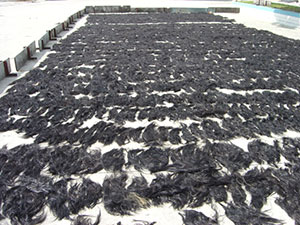Remy Hair Extensions Description, Meaning and Terminology
 The term "Remy Hair" describes hair woven in to hair wefts, clip in's or wigs which are manufactured completely from human hair in which each strand of hair, (once cut from a human donors scalp) runs from root to tip once sewn into the hair weft, wig or clip in and contains no mixing of animal or synthetic hair. The term "Remy Hair" describes hair woven in to hair wefts, clip in's or wigs which are manufactured completely from human hair in which each strand of hair, (once cut from a human donors scalp) runs from root to tip once sewn into the hair weft, wig or clip in and contains no mixing of animal or synthetic hair.
To understand the importance of the above consider this: > The majority of hair extensions sold around the world should be classified "NON-Remy" because they use the term "Remy" as a NAME, rather than a TECHNICAL DESCRIPTION and is often mixed with animal and synthetic hair which is then heavily coated in silicone to give it a silky natural feel (which dissipates following shampooing).
The natural cuticle layer is removed from all processed hair except "Virgin Remy Hair" because following removal from the vat where the hair is cleaned and coloured it is impossible to get the hair to run root-point-correct and therefore the hair would be impossible to manage as opposite running cuticle acts like Velcro.
Unfortunately many manufacturers produce hair extensions which they "Name" Remy, but is not because they blend it with animal and or synthetic hair and the consumer is fooled because the hair is coated heavily with silicone which makes it feel silky at point of sale. Fake Remy hair is difficult to spot, difficult to style and its lustre lasts no more than one shampoo.
 Processing Remy HairReal Remy hair can originate from any country in the world, Indian Remy hair is generally accepted to be amongst the best because the donors do not chemically treat their hair. Real Remy hair is donated or sold to hair farmers who sell it on to the factories who process the hair.
1. Hair is donated by ladies during Tonsuring
2. Hair is sorted into lengths, cleaned and laid in the sun to dry.
3. The hair is sorted into knots of various weight and quality.
4. The hair is sold to processors such and their manufacturing partners.
5. The hair is dyed and packaged ready for sale.
|
|
|